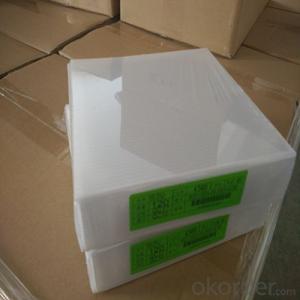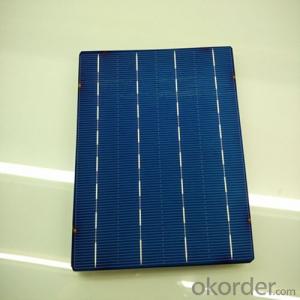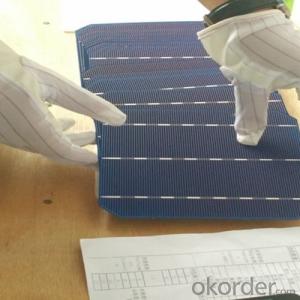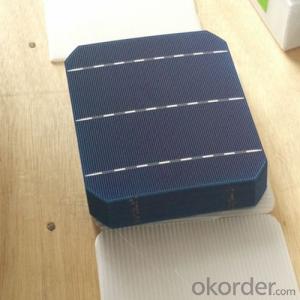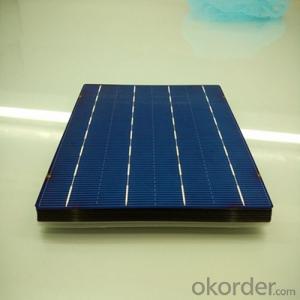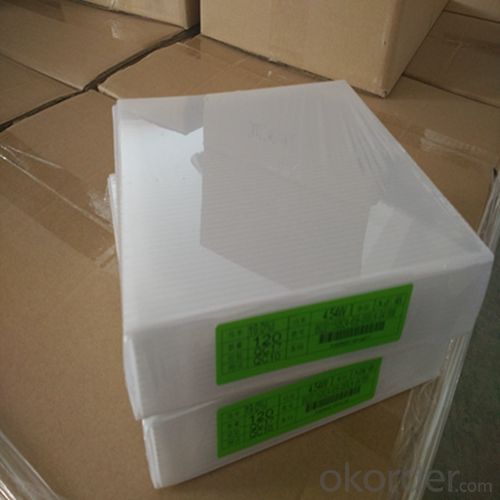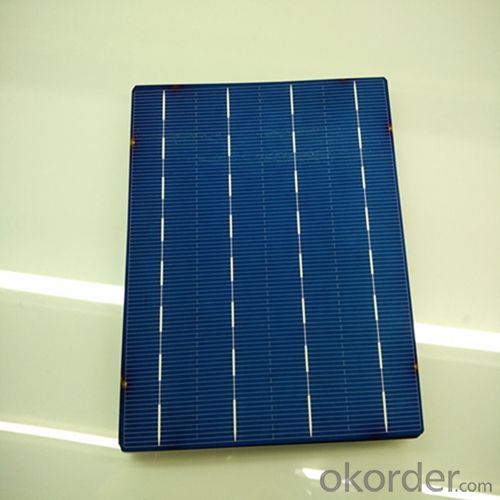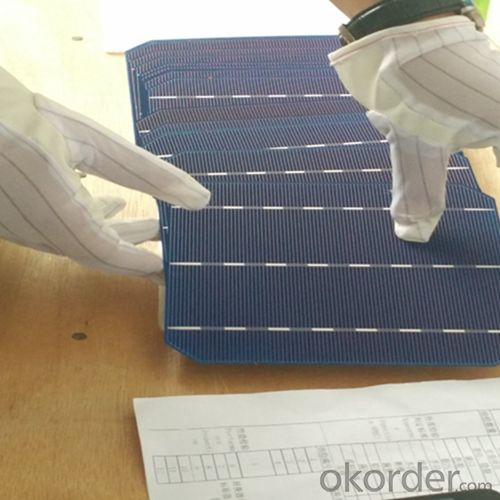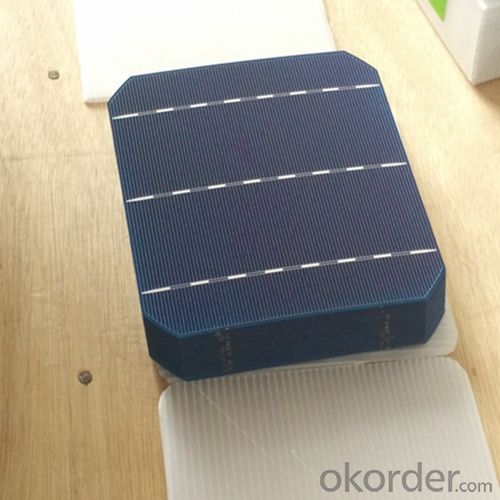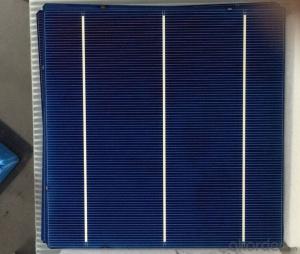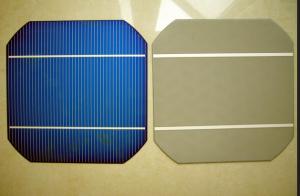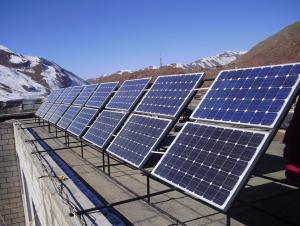Fiber Based Poly 156x156mm2 Solar Cells - Class 2BB
- Loading Port:
- Shanghai
- Payment Terms:
- TT or LC
- Min Order Qty:
- 3999 watt
- Supply Capability:
- 6000000 watt/month
OKorder Service Pledge
OKorder Financial Service
You Might Also Like
The operation of a photovoltaic (PV) cell requires 3 basic attributes:
The absorption of light, generating either electron-hole pairs or excitons.
The separation of charge carriers of opposite types.
The separate extraction of those carriers to an external circuit.
In contrast, a solar thermal collector supplies heat by absorbing sunlight, for the purpose of either direct heating or indirect electrical power generation from heat. A "photoelectrolytic cell" (photoelectrochemical cell), on the other hand, refers either to a type of photovoltaic cell (like that developed by Edmond Becquerel and modern dye-sensitized solar cells), or to a device that splits water directly into hydrogen and oxygen using only solar illumination.Characteristic of Mono 156X156MM2 Solar Cells
You are gaining energy independence - add battery backup power for even greater energy security
The cost of electricity is only going to rise – insure against that rising cost
Adaptive cells change their absorption/reflection characteristics depending to respond to environmental conditions. An adaptive material responds to the intensity and angle of incident light. At the part of the cell where the light is most intense, the cell surface changes from reflective to adaptive, allowing the light to penetrate the cell. The other parts of the cell remain reflective increasing the retention of the absorbed light within the cell.[67]
In 2014 a system that combined an adaptive surface with a glass substrate that redirect the absorbed to a light absorber on the edges of the sheet. The system also included an array of fixed lenses/mirrors to concentrate light onto the adaptive surface. As the day continues, the concentrated light moves along the surface of the cell. That surface switches from reflective to adaptive when the light is most concentrated and back to reflective after the light moves along
Mechanical data and design
Format | 156mm x 156mm±0.5mm |
Thickness | 210μm±40μm |
Front(-) | 1.5mm bus bar (silver),blue anti-reflection coating (silicon nitride) |
Back (+) | 2.5mm wide soldering pads (sliver) back surface field (aluminium) |
Temperature Coefficient of Cells
Voc. Temp.coef.%/K | -0.35% |
Isc. Temp.coef .%/K | +0.024%/K |
Pm.Temp.coef. %/K | -0.47%/K |
Electrical Characteristic
Effiency(%) | Pmpp(W) | Umpp(V) | Impp(A) | Uoc(V) | Isc(A) | FF(%) |
18.35 | 4.384 | 0.526 | 8.333 | 0.63 | 8.877 | 78.39% |
18.20 | 4.349 | 0.526 | 8.263 | 0.63 | 8.789 | 78.54% |
18.05 | 4.313 | 0.525 | 8.216 | 0.63 | 8.741 | 78.32% |
17.90 | 4.277 | 0.524 | 8.161 | 0.625 | 8.713 | 78.04% |
17.75 | 4.241 | 0.523 | 8.116 | 0.625 | 8.678 | 77.70% |
17.60 | 4.206 | 0.521 | 8.073 | 0.625 | 8.657 | 77.36% |
17.45 | 4.170 | 0.519 | 8.039 | 0.625 | 8.633 | 76.92% |
17.30 | 4.134 | 0.517 | 8.004 | 0.625 | 8.622 | 76.59% |
17.15 | 4.096 | 0.516 | 7.938 | 0.625 | 8.537 | 76.80% |
17.00 | 4.062 | 0.512 | 7.933 | 0.625 | 8.531 | 76.18% |
16.75 | 4.002 | 0.511 | 7.828 | 0.625 | 8.499 | 75.34% |
16.50 | 3.940 | 0.510 | 7.731 | 0.625 | 8.484 | 74.36% |
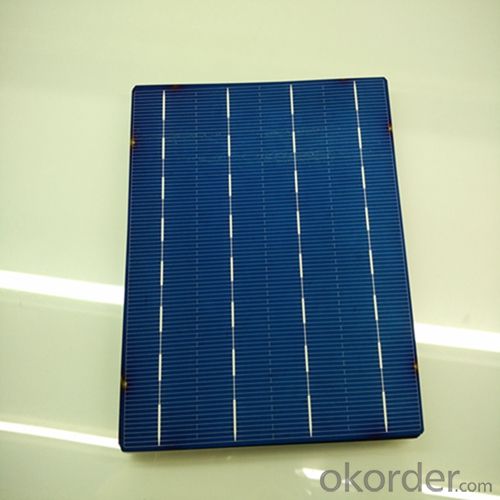
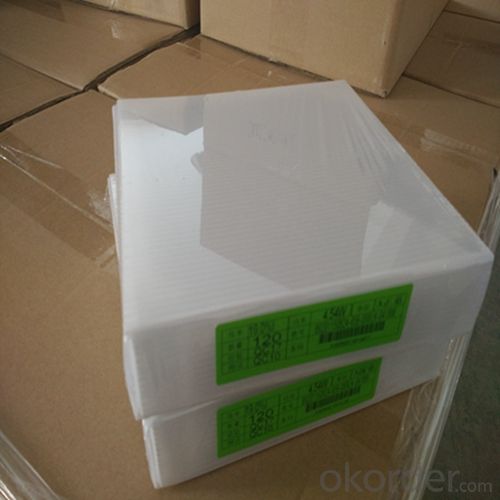
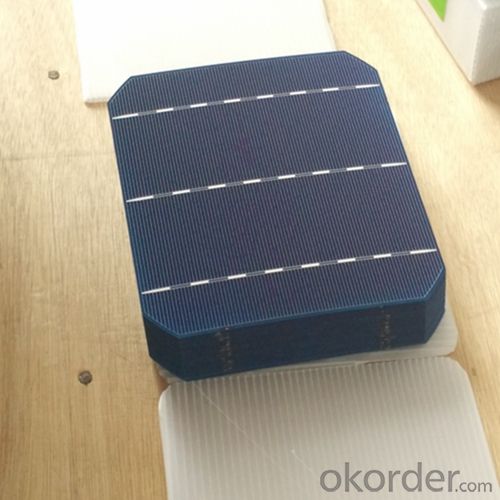
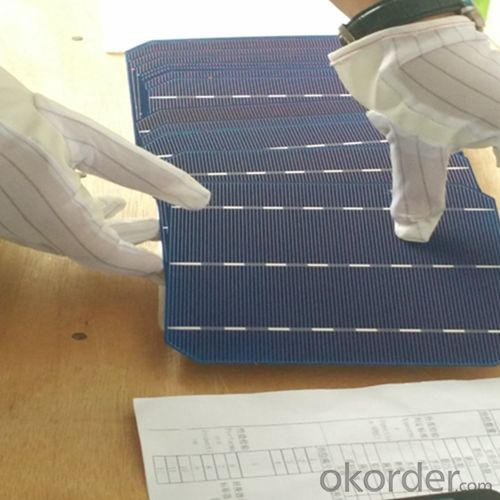
 FAQ
FAQ
Q: What price for each watt?
A: It depends on the quantity, delivery date and payment terms, generally Large Quantity and Low Price
Q: What is your size for each module? Can you tell me the Parameter of your module?
A: We have different series of panels in different output, both c-Si and a-Si. Please take the specification sheet for your reference.
Q: What is your size for each module? Can you tell me the Parameter of your module?
A: We have different series of panels in different output, both c-Si and a-Si. Please take the specification sheet for your reference.
A solar cell is an electronic device which directly converts sunlight into electricity. Light shining on the solar cell produces both a current and a voltage to generate electric power. This process requires firstly, a material in which the absorption of light raises an electron to a higher energy state, and secondly, the movement of this higher energy electron from the solar cell into an external circuit. The electron then dissipates its energy in the external circuit and returns to the solar cell. A variety of materials and processes can potentially satisfy the requirements for photovoltaic energy conversion, but in practice nearly all photovoltaic energy conversion uses semiconductor materials in the form of a p-n junction.
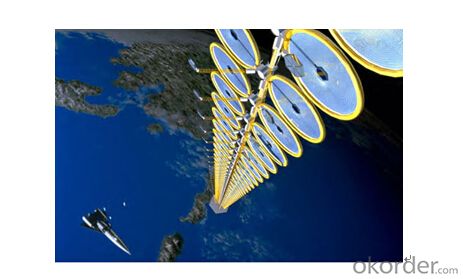
The basic steps in the operation of a solar cell are:
the generation of light-generated carriers;
the collection of the light-generated carries to generate a current;
the generation of a large voltage across the solar cell; and
the dissipation of power in the load and in parasitic resistances.
Solar cells are structured in layers with different functions. The working principle is the same as in semiconductors.
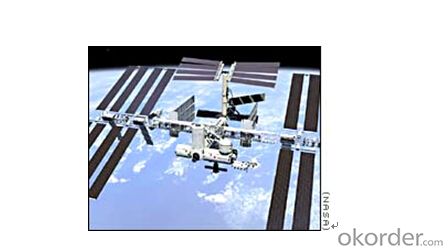
The main part of a silicon (Si) solar cell generating solar power is formed by two differently doped (n- and p-) silicon layers. A physical barrier is created between them along the p-/n- junction, with electrons and holes diffusing into regions of lower concentration.
This depleted region or space charge region can only be overcome with the help of photons i.e. sunlight.
To be able to channel electrones and holes and generate electric power, metal contacts need to be printed onto the front and rear side. Generally, a full aluminium or silver layer is screenprinted onto the rear. A thin grid forms the front contact keeping the impact on light entering the silicon cells as low as possible.

To reduce light reflection, a thin film of silicon nitride or titanium dioxide is coated onto the surface.
- Q: Can solar cells be used for electric vehicle charging?
- Yes, solar cells can be used for electric vehicle charging. Solar panels can convert sunlight into electricity, which can then be used to charge electric vehicles. This process, known as solar charging, provides a sustainable and renewable energy source for EVs, reducing their dependence on the grid and decreasing carbon emissions.
- Q: Can solar cells be used in commercial applications?
- Yes, solar cells can be used in commercial applications. They are widely used in various sectors such as energy production, agriculture, telecommunications, transportation, and construction. Solar panels are employed to generate electricity for commercial buildings, provide power to remote areas, run water pumps, charge electric vehicles, and more. The cost-effectiveness, sustainability, and growing efficiency of solar technology have made it a viable option for businesses to reduce their carbon footprint and save on energy costs.
- Q: Are solar cells affected by extreme temperatures?
- Yes, solar cells are indeed affected by extreme temperatures. High temperatures can cause solar cells to degrade and operate less efficiently, resulting in a decrease in power output. Similarly, extremely low temperatures can also reduce the performance of solar cells, although to a lesser extent. Therefore, it is important to consider temperature conditions when designing and installing solar panels to optimize their performance and longevity.
- Q: What is the typical size and weight of a solar cell?
- The typical size of a solar cell ranges from a few square centimeters to several square meters, while the weight can vary from a few grams to a few kilograms, depending on the technology and application.
- Q: Can solar cells be used in agricultural farms?
- Yes, solar cells can be used in agricultural farms. They can be utilized to generate electricity for various purposes on the farm, such as powering irrigation systems, lighting, and machinery. Solar energy can help reduce dependence on fossil fuels, lower energy costs, and promote sustainable farming practices.
- Q: I studied very hard at school, but I just can not figure out how solar cells work, anybody can help me with that?
- The principle of solar cells is quite difficult to understand.
- Q: Can solar cells be used for powering remote weather stations?
- Yes, solar cells can be used for powering remote weather stations. Solar cells convert sunlight into electricity, which can be stored in batteries for use when sunlight is not available. This makes them a reliable and sustainable power source for remote locations where access to the electrical grid may be limited. Additionally, solar cells are low maintenance and can operate for long periods without human intervention, making them an ideal choice for powering weather stations in hard-to-reach areas.
- Q: Can solar cells be used for off-grid living?
- Yes, solar cells can be used for off-grid living. Solar cells, also known as photovoltaic cells, convert sunlight into electricity. This renewable energy source can be harnessed to power various appliances and systems in off-grid homes, providing a sustainable and independent energy solution. By storing excess electricity in batteries, solar cells ensure a continuous power supply even during cloudy or nighttime conditions. This makes them a reliable and cost-effective option for off-grid living, reducing reliance on traditional power grids and minimizing environmental impact.
- Q: Can solar cells be used in recreational vehicles (RVs)?
- Yes, solar cells can be used in recreational vehicles (RVs). Solar panels can be installed on the roof of an RV to generate electricity from sunlight, which can then be used to power various appliances and systems in the vehicle. This provides a sustainable and eco-friendly way to generate power while on the road.
- Q: How do solar cells perform in snowy conditions?
- Solar cells do not perform optimally in snowy conditions due to the reduced sunlight reaching the cells. Snow cover can significantly decrease the efficiency of solar panels as it blocks sunlight from reaching the cells, limiting their ability to generate electricity. Additionally, snow accumulation on the panels can create a physical barrier that further hinders their performance. Regular cleaning and tilting the panels to shed snow are some ways to mitigate the impact of snowy conditions on solar cell performance.
Send your message to us
Fiber Based Poly 156x156mm2 Solar Cells - Class 2BB
- Loading Port:
- Shanghai
- Payment Terms:
- TT or LC
- Min Order Qty:
- 3999 watt
- Supply Capability:
- 6000000 watt/month
OKorder Service Pledge
OKorder Financial Service
Similar products
Hot products
Hot Searches
Related keywords
